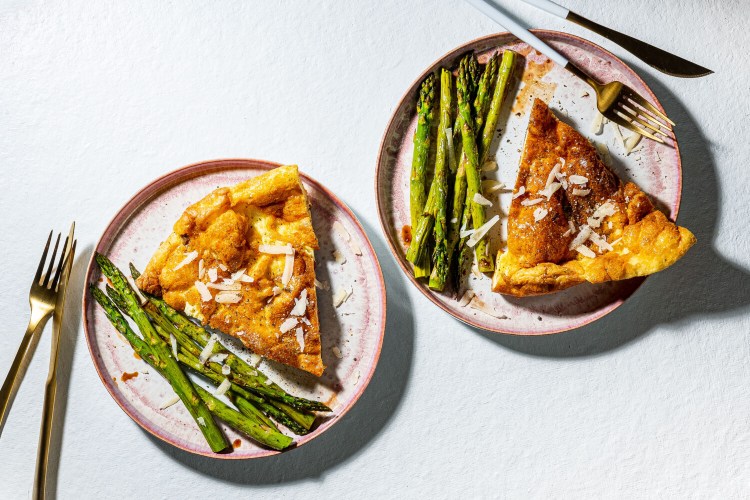Years ago, a friend and I got into a months-long back-and-forth about carbonara. The pasta dish of cheese and pork, creamy with eggs and silky with starchy pasta water, is one of Rome’s most revered exports. There are maybe hundreds of ways to make it, and lots of little rules, and my friend and I probably tried them all.
Sometimes we’d cook together, arguing over whether the pasta water was salty enough or the cheese was grated finely enough. Sometimes we’d cook it in our separate kitchens, texting updates and photos as we went along, comparing hits and misses.
I loved these sessions, and how my friend, who’d had many more versions of carbonara, in Italy and beyond, added little insights to my general cooking knowledge that got me thinking about pasta, Italian cooking theory and even life in different ways. At some point, I think, we settled on a formula we agreed was “our best.”
But what I realized after we’d come up with our (personal!) winning recipe was that what I like most about carbonara is that it’s endlessly adaptable. Some will say, of course, that if it contains anything besides pasta, pancetta, cheese, eggs, salt and pepper, it’s not carbonara. If that’s you, consider joining this support group.
One weekend afternoon, after I’d slept in and forgot to have anything meaningful to eat all day, I was craving something like carbonara, but wanted to go heavier on the protein. Thus, frittata carbonara. It can certainly be brunch or lunch, but with a side of roasted asparagus drizzled with balsamic vinegar, why not make it dinner tonight?
Frittata Carbonara With Balsamic Asparagus
Active time: 20 minutes | Total time: 40 minutes
4 to 6 servings
Carbonara is a traditional Italian pasta dish with egg, cheese and pork. Here, those flavors are baked into a frittata, similar to a crustless quiche. It comes together quickly: cook chopped bacon (or use guanciale or pancetta), then whisk it into eggs with cream and Parmesan before pouring the mixture back over the rendered pork fat. It puffs nicely as it bakes. Roast asparagus at the same time, toss it with a bit of balsamic vinegar – use a well-aged one here, if you have it – and serve it on the side.
Storage Notes: Leftover frittata can be refrigerated in an airtight container for up to 3 days.
INGREDIENTS
12 ounces (15 to 25 stalks) asparagus, woody ends trimmed off
2 teaspoons olive oil
1/4 teaspoon kosher salt, or more as needed
4 slices (about 7 ounces) thick-cut bacon, cut into 1/2-inch strips
8 large eggs
1/2 cup heavy cream
1/4 teaspoon coarsely ground black pepper, plus more as needed
5 ounces Parmesan cheese, grated or shredded, plus more for garnish, if desired
1 tablespoon balsamic vinegar
DIRECTIONS
Position the racks in the lower third and middle of the oven and preheat to 400 degrees. Spread the asparagus on a large, rimmed baking sheet, drizzle with the olive oil and sprinkle with a pinch of salt. Using tongs, toss until coated.
In an 8- to 10-inch wide ovenproof, preferably nonstick skillet over medium to medium-high heat, cook the bacon, using a wooden spoon or spatula to move it around so it cooks evenly, until it renders its fat and just starts to crisp around the edges, 8 to 10 minutes. Remove from the heat, but leave the bacon in the pan.
In a large bowl, whisk together the eggs, cream, 1/4 teaspoon of salt and the pepper until smooth. Stir in the Parmesan and add the bacon, leaving the remaining bacon grease in the pan. Add the egg mixture back into the pan and cook over medium heat until the frittata starts to set around the edges, about 5 minutes.
Bake the frittata and the asparagus at the same time. Transfer the skillet to the center rack of the oven and bake for 10 to 12 minutes, or until the frittata is puffed and fully set. Place the asparagus on the lower rack in the oven and roast for 10 to 12 minutes, or until bright green and tender. Remove the asparagus from the oven, drizzle with the balsamic vinegar and toss to coat.
Slide or flip the frittata onto a plate, garnish with Parmesan and more cracked black pepper, if desired, slice and serve with the balsamic asparagus.
Nutrition (based on 6 servings) | Calories: 445; Total Fat: 37 g; Saturated Fat: 16 g; Sodium: 787 mg; Carbohydrates: 5 g; Dietary Fiber: 1 g; Sugars: 2 g; Protein: 23 g.
Send questions/comments to the editors.




Comments are no longer available on this story